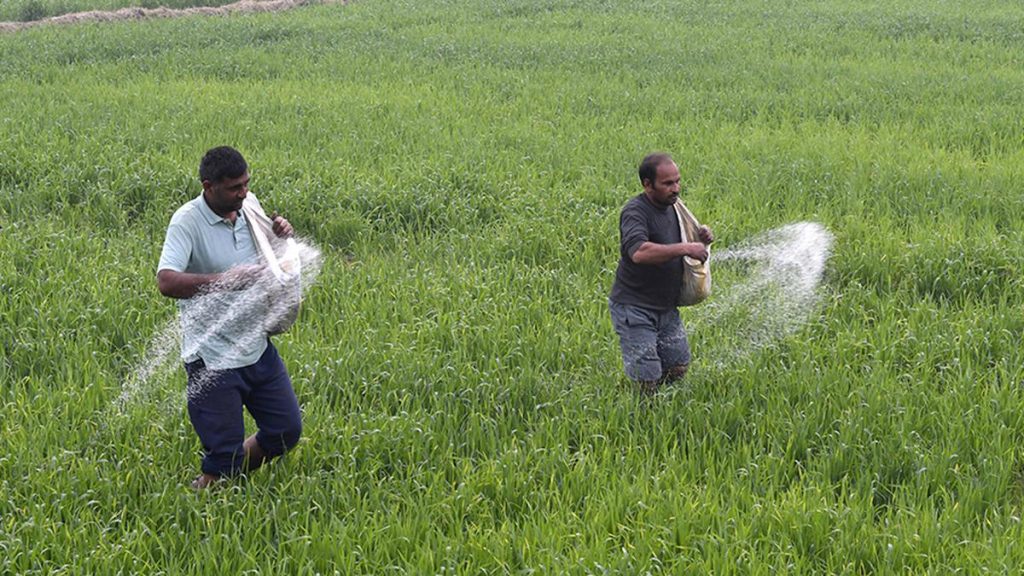Tags
Nano-urea led to decrease in yield, protein content of rice and wheat: Study.
The application of nano-urea, in the manner prescribed by IFFCO, led to a decrease in the protein content in rice and wheat grains by 35% and 24%, respectively, the study found.
Jacob Koshy.

One of the largest and most sustained trials analysing the impact of nano-urea on crop yields has concluded that its continued use could reduce yields of rice and wheat, which together constitute about 70% of India’s annual foodgrains output.
Promoted by the fertiliser company IFFCO, and extensively promoted by the government’s Department of Fertilisers, the application of nano-urea, in the manner prescribed by the company, led to a decrease in the protein content in rice and wheat grains by 35% and 24%, respectively, the study found.
“Premature and long-term adoption of such nitrogen-management practice may lead to yield losses besides reduction in grain and straw-nitrogen content,” the authors from the Punjab Agricultural University, Ludhiana, said in their peer-reviewed study in the journal Plant Soil this month, adding, “…a rational understanding on the long-term impacts is required else it might inadvertently harm the economic benefits and livelihoods of the growers”.
Urea, a solidified nitrogen fertiliser, is critical to India’s agricultural economy. India needs about 350 lakh tonnes of urea annually, for which 40 lakh tonnes have to be imported. However, urea in India is heavily subsidised, with a 45-kg bag actually costing around ₹3,000 but sold at ₹242 to farmers. In 2023-24, the government spent ₹1.3 lakh crore on urea. A bag of urea provides about 20 kg of nitrogen in a form usable by plants.
Into this sector came a technological innovation called “nano-urea”. A half-litre solution of nano urea contains 4% (w/v) N equivalent to 20g N, or about one-thousandth of the nitrogen in a bag. IFFCO, however, claims that one spray of a 500 ml solution of nano-urea can substitute more than 52 kg of N ha−1 as commercial urea in a number of crops, irrespective of soil and climatic conditions. This is because nano-urea is converted to nanoparticles, and therefore made more bio-available, and if applied in a prescribed manner at appropriate stages of rice and wheat plant development, can substitute the conventional bag. Moreover, unlike conventional urea that is applied to the roots, nano urea is sprayed on the leaves at two critical flowering stages of the plants.
Thus, rather than farmers deploying two bags of urea for a hectare of rice to provide the nitrogen required for a hectare, they could instead use one bag, and substitute the other bag with liquid nano-urea with no loss of yield. A bottle of urea costs a little more than a 45 kg bag or around ₹260. The claim was that this would eventually reduce aggregate urea consumption and lead to savings on the import bill.
However, since its commercial release in 2022, evidence for nano-urea as a reliable substitute has been thin. “Despite previous positive results in trials conducted by IFFCO, there has been mixed evidence, and so we felt it was necessary to conduct a careful trial,” Rajeev Sikka, who led the study and is a senior soil chemist at the Punjab Agricultural University, Ludhiana, said.
His study was funded by the IFFCO, which has also funded several other trials in other institutions. Yield gains, plant physiology suggested, were correlated with uptake of nitrogen in the soil from the roots. However, in their studies, they showed a “reduction” in root attributes (length and dry weight), and nutrient content. “What’s happening is that in the two years (2021 and 2022) we conducted our studies, the plants were unable to use the urea sprayed as nano-urea. Whatever was available was from the soil, so naturally this will reduce yields,” Professor Sikka told The Hindu.
“Newer formulations of nano-urea, which had 8% N and 20% N were being brought out by the company and these too had failed to increase yields, according to tests conducted at his institute,” Prof. Sikka said. But the latter results have not been published yet.
Published Date: January 25, 2025






